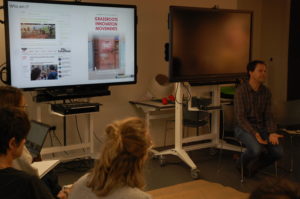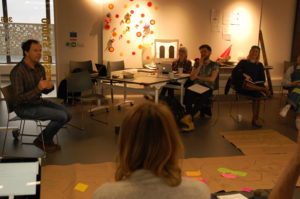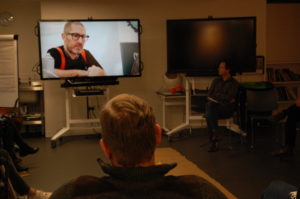Each week, the System Change Hive is exploring and experimenting with new solutions to societal and environmental problems, through creative arts practice. Artworks created will be exhibited in different locations around the UK and showcased online. The group is comprised of artists, communication experts, activists and STEPS researchers.
In week 5, the session began by splitting up into smaller groups, sharing ideas about how the exhibition might look and feel. Linked to this is a much broader question: if you could shape the world you wanted, what would it look and feel like? I felt inspired by the collective desire expressed by the group to create something responsive; to listen to and learn from each other, and interact with the public. I felt a palpable buzz of excitement and nerves in the room as the group was thinking through ideas for how this might work in practice.
The atmosphere was one of dreaming; of ‘imagineering’, distilled into an open-ended question, ‘what if…?’ Adrian Smith (SPRU/ STEPS Centre) gave the week’s academic contribution, which responded well to this creative questioning. He talked about the growing phenomenon of community-based, shared workshops, known as hackerspaces, fablabs or makerspaces, which are equipped with design, prototyping and fabrication tools. These spaces open up various social, economic and environmental possibilities, and a number of ‘what if…?’ questions came to my mind: such as,
- ‘What if technology really served people rather than entrapping them?’
- ‘What if people were free to choose technologies based on their environmental & social benefits, rather than cost efficiency?’
- ‘What if we had free access to tools & spaces to imagine new ways of being in the world?’

Adrian played a video that introduced what a fablab looked like. I have since found on YouTube numerous similar videos for other fablabs and makerspaces. The videos showcase the fancy equipment; often machines that cut and construct things with lasers. We see smiling people show off the shapes and objects they are making using these machines, talking about how they feel empowered to make things, ‘anything’, and be creative. They are reimagining their relationships with technology – as producers and not just consumers, which is brilliant. However, watching these videos, I found myself feeling a little less impressed than I thought I would be. In the context of the System Change Hive, these videos don’t, I think, tell the whole story of what these spaces are for.

For example, fablabs are often portrayed as catalysts for new models of production and consumption, aiming to create value for many rather than profit for a few. However, teaching more people to be producers is not necessarily supporting better ones (i.e. more environmentally conscious). So, how can these spaces be environmentally sustainable?
In a maker space, full of state-of-the-art kit, it is possible to make anything one could wish to make. Anyone can use a fab lab, but do they? And if not, why not? Issues of accessibility are not solved simply by creating a physical space, opening the doors and inviting people in. Some people experience less-tangible barriers and restrictions, dictated, for example, by social and cultural stigmas and prejudices, or simply a lack of confidence. How can these spaces also be socially just?
Over the course of the last few years, Adrian’s research has taken him along these lines of questioning. In this blog, he summaries some responses to these issues. At the System Change Hive, he shared one example of how community-spaces are aiming to address sustainability and social justice issues: the Restart Party. Specifically, he showed this video from a Restart Party event in London.

Restart parties teach repair to members of the community, for free, and encourage people to rethink their relationships with their machines. This video sparked a conversation among the Hive group about our frustrations with technology; times when we feel trapped, stuck with limited choices. We also discussed how it is we make choices about which technology to use, particularly with regards to computers, tablets and phones. For example, a completely modular phone or computer that can be taken apart and put together, may empower some people to fix things, but it might be intimidating for others. What kind of system might be required to address this? Could repair workshops be opened on high streets? What if a modular device wasn’t sophisticated enough for our requirements or needs? Might this encourage us to reflect more on what our needs really are?
Based on these videos, repair cafes appealed to me more than fablabs. They seemed more charming, people-oriented – the social, ‘gathering’ function of the spaces came through more prominently. They featured men and women of various ages. It became apparent that there are many people who need help with their technology, but there are also a lot of people who want to offer help.
I particularly like this video from a repair café in Palo Alto, in which one of the volunteers enthuses that, ‘There is no set way to fix something ... There are probably five or six different solutions to each problem and it’s not clear always which is the best one.’ I think this joyful attitude towards exploring many possible solutions to problems is something to be admired and encouraged.
Makerspaces, such as fablabs and repair cafes, are a place for doing and relating to technology differently. They can also be spaces for meeting, sharing and collectively dreaming; for relating to each other differently, which is something that, at the Hive, we are particularly interested about.
Find out more about the System Change Hive on the project website.
Follow the System Change Hive on Twitter and Instagram.
